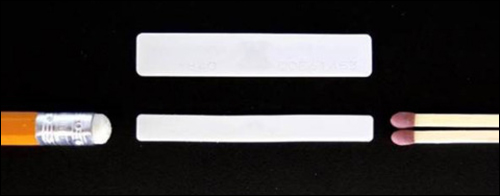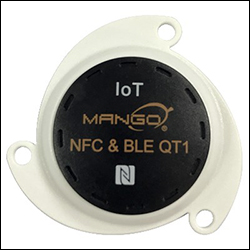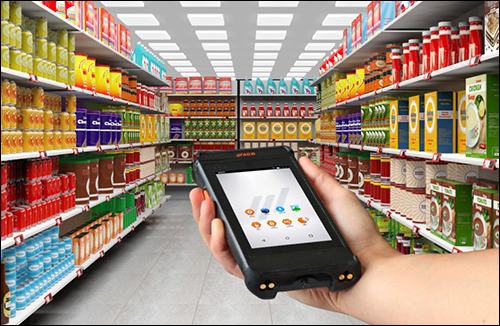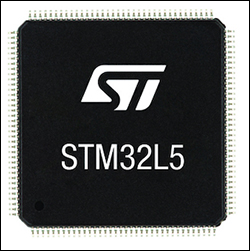Feb 20, 2020Presented here are news announcements made during the past week by the following organizations:
Fujitsu Frontech North America;
Tatwah;
ACD Group;
Tuya Smart; and
STMicroelectronics.
Fujitsu Frontech North America Intros Washable RFID Linen Tag
Fujitsu Frontech North America has launched its WT-A543 RFID Linen Tag. With a 7-millimeter form factor, the tag is 30 percent smaller than the previous generation and can be inserted into any hem, the company reports.
"The new WT-A543 RFID Linen Tag demonstrates our commitment to design innovation," said Michi Sugawara, Fujitsu Frontech North America's president and CEO, in a prepared statement. "By improving the performance and durability of our RFID tag while reducing the width, we are enabling manufacturers to easily integrate our tags into a broader range of products."

The tag is intended for flat linen processing using high pressure extractors and flatwork ironers. The smaller size allows it to be directly inserted into virtually any linen, garment or textile, according to the company. When sewn into seams, the tag is designed to be unobtrusive and unnoticeable. The WT-A543 tag is suitable for any type of linen used in hospitality, health care, hotel and casino, food and beverage, and entertainment applications.
The tag's design allows for high-density readability and a controlled read range, the company reports, providing the ability to read tagged items in a multitude of in-process locations without reading other RFID tags in the local area. This allows users to manage internal processes rather than merely reading tags before shipment. Garment and linen owners can use the tag for asset tracking, loss reduction, and workflow and efficiency improvement. The tag is available through Fujitsu Frontech North America's authorized distribution partners.
Tatwah Offers Ultra-Low-Power Bluetooth 5 Beacons
Tatwah, an Internet of Things (IoT) solutions company, has announced a new generation of its Bluetooth Low Energy (BLE) beacons. The latest beacons are designed to enable systems integrators to monitor and track the activities of industrial assets, as well as analyze data and run AI algorithms on on-prem or cloud servers.
Tatwah's MANGO-branded BLE beacons support iBeacon, Eddystone, AltBeacon and proprietary formats. They feature configuration options, operational parameters and an NFC tag interface that can be used to store information about an asset, maintenance data or localization. The beacons are designed with a modular approach for multi-sensor capabilities, security enhancements and customization, the company reports.

The devices are based on the RSL10 radio from ON Semiconductor, which provides ultra-low-power BLE connectivity, while helping to reduce overall system size and bill of materials (BoM). The RSL10 come with a suite of firmware, software and mobile app offerings.
The beacons have been deployed in various ecosystems, according to the company, and are supported by such IoT cloud platforms as AWS, Ayla and EVRYTHNG. They have been adopted by a range of systems integrators and end customers, and are intended to help companies connect their smart products via BLE, RFID, NFC and other RF connectivity options.
"With this new beacon family, Tatwah is instrumental in providing Bluetooth Low Energy beacons leveraged end-to-end IoT solutions like asset tracking to clients," said Egon Konopitzky, Tatwah's senior executive VP, in a prepared statement. "Tatwah is extending its product offering to enable solutions in industries like predictive maintenance, smart building and cities, healthcare, wearable patches, people monitoring, inventory management, retail, logistics, etc., We will be extending our product portfolio with new and enriched devices all along 2020."
ACD Group Unveils Terminal That Can Accommodate RFID Readers
ACD Group has announced its M2Smart modularly structured manual terminal, which comes with various attachable modules that can be connected using an insert or slide mechanism. Numerous attachable modules are possible, including RFID readers, printers, distance sensors, temperature modules, 1D and 2D long-range scanners, and keyboard variants.
The modules can be adapted and implemented for specific customer requirements, the company reports. Optionally available are the company's M2Key16 keyboard variant, as well as its M2Temperature temperature module for measuring core and surface temperatures.

The individual modules can be exchanged without a tool, using an insert or slide mechanism, in order to provide efficient and flexible work on the sales floor, in incoming goods, in the warehouse and in production areas. This modularity makes it possible to configure customer-specific modules, the company reports. The system uses the Android Industrial+ operating system.
The Android version can be adapted to customer needs, according to the company. Hardware components that require fundamental adjustments to the operating system can be integrated. ACD takes responsibility for support, incorporates security updates and provides assistance with troubleshooting, as well as rapid response to security gaps.
The hardware behind the M2Smart ACD is also visible. The basic device, with a sturdy main housing and a 4.8-inch capacitive display, was developed internally by ACD Elektronik GmbH. An integrated lithium-ion battery provides long operating times, the company reports, and can be changed during ongoing operation. The system comes with a Qualcomm Snapdragon processor, an integrated 2D scanner and a camera with illumination. Optionally available, in addition to various modules including keyboards and temperature sensors, are WLAN to IEEE 802.11a/b/g/n, BT-compatible close-range radio and a DS2Smart docking station.
Tuya Smart Announces NB-IoT Module for Smart Cities, Health Care, Agriculture
IoT platform provider Tuya Smart has announced a narrowband-IoT (NB-IoT) module designed to enable and accelerate smart cities, smart homes, smart health care and smart agriculture.
According to Tuya Smart, its NM1 NB-IoT module is certified in Europe, North America and Asia by the State Radio Regulation of China (SRRC), Network Access License (NAL), China Compulsory Certification (3C), CE and the Federal Communications Commission (FCC). Through these certifications, NB-IoT enables Tuya to enter additional global markets in Europe, North America and Asia.
Narrowband radio technology is suitable for Internet of Things devices and applications because it extends wireless range and battery life and uses less power. Additionally, narrowband radio technology has 50 to 100 times more connection capacity than 2G, 3G and 4G, the company reports, and works in low-signal places such as underground tunnels, parking lots and basements.
"As a leader in IoT smart home solutions, NB-IoT is a natural fit for our AI+IoT platform to disrupt the sharing economy and develop smart cities," said David Funk, Tuya Germny's head of business expansion, in a prepared statement. "We foresee use of Tuya's NB-IoT module in smart healthcare and smart agriculture, as well as products such as washing machines, water meters, and electrical and natural gas meters." NB-IoT will be added to Tuya Smart's supported AI+IoT platform protocols alongside Wi-Fi, Bluetooth, Zigbee and Z-Wave.
STMicroelectronics Microcontrollers Add Security for IoT Applications
STMicroelectronics has announced its STM32L5x2 microcontrollers (MCUs), designed to provide security for IoT-connected applications. Operating at clock frequencies up to 110 MHz, the STM32L5-series MCUs contain Arm's Cortex-M33 32-bit RISC core, with Arm's TrustZone hardware-based security. The system authenticates devices connected to a network by creating a protected execution environment for cyber-protection and sensitive code (cryptography and key storage) that blocks attempts to corrupt devices or software. A second, independent execution environment allows for the running of untrusted code.
The solution allows users to include or exclude each I/O, peripheral, or area of Flash or SRAM from TrustZone protection, allowing sensitive workloads to be isolated for maximum security. In addition, ST has engineered TrustZone to ensure support for secure boot, special readout and write protection for integrated SRAM and Flash, and cryptographic acceleration, including AES 128/256-bit key hardware acceleration, public key acceleration (PKA), and AES-128 On-The-Fly Decryption (OTFDEC), to protect external code or data. The STM32L5 supports active tamper detection and secure firmware installation.

"As IoT and embedded devices increase in intelligence and functionality, security must be built in from the ground up," said Thomas Ensergueix, the senior director of Arm's Automotive and IoT Line of Business, in a prepared statement. "The STM32L5 series makes it easier for developers to build trusted PSA Certified devices based on the Arm Cortex-M33 processor, providing a robust and secure foundation for devices ranging from consumer products to industrial equipment."
The STM32L5x2 MCUs offer 512 kilobytes of dual-bank Flash memory to allow read-while-write operation to aid device management, the company reports, while the Flash memory ensures safety by supporting Error Correction Code (ECC) with diagnostics. There are a 256-kilobyte-SRAM and features to support high-speed external memory, including single, dual, quad or octal SPI and Hyperbus Flash or SRAM, along with an interface for SRAM, PSRAM, NOR, NAND or FRAM.
Digital peripherals for the STM32L5x2 include USB Full Speed with dedicated supply, allowing customers to keep USB communication even when the system is powered at 1.8 volts, and a UCPD controller compliant with USB Type-C Rev. 1.2 and USB Power Delivery Rev. 3.0 specifications. Smart analog features include an analog-to-digital converter (ADC), two power-gated digital-to-analog converters (DAC), two ultra-low-power comparators, and two operational amplifiers with external or internal follower routing and programmable-gain amplifier (PGA) capability.
The STM32L5 series is supported by the STM32 ecosystem and features its own STM32CubeL5 software package, which includes Hardware Abstraction Layer and Low-Level drivers, FreeRTOS, Trusted Firmware-M (TF-M), Secure Boot and Secure Firmware Update (SBSFU), USB-PD device driver, MbedTLS and MbedCrypto, FatFS file system, and Touch Sensing drivers. The STM32CubeL5 features more than 300 project examples that can run on the STM32L552E-EV evaluation board, STM32L562E-DK discovery kit and NUCLEO-L552ZE-Q. These projects can be compiled with the Arm Keil development tool, IAR or STM32CubeIDE toolchains, and are delivered with a STM32CubeMX configuration file, enabling easy customization and code update.

